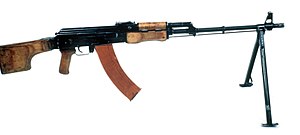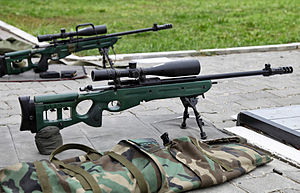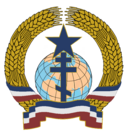Letnian Army: Difference between revisions
Jump to navigation
Jump to search
m (1 revision imported) |
No edit summary |
||
| Line 1: | Line 1: | ||
{{infobox national military | {{infobox national military | ||
|country = [[ | |country = [[Letnia]] | ||
|name = | |name = Imperial Letnian Army | ||
|native_name = | |native_name = Императорская Летная Армия | ||
|image = [[File: | |image = [[File:LetniaArmyFlag.png|300px]] | ||
|caption = Army Flag adopted in 1992 | |caption = Army Flag adopted in 1992 | ||
|image2 = | |image2 = | ||
|caption2 = | |caption2 = | ||
|founded = | |founded = 1487 | ||
|current_form = | |current_form = 1705 | ||
|disbanded = | |disbanded = | ||
|branches = | |branches = | ||
|headquarters = Turov, | |headquarters = Turov, Letnia | ||
|flying_hours = | |flying_hours = | ||
<!-- Leadership --> | <!-- Leadership --> | ||
|commander-in-chief = | |commander-in-chief = [[Tsarina Katerina II]] | ||
|commander-in-chief_title= | |commander-in-chief_title= Tsarina of Letnia | ||
|minister = Kashnikov Milorad | |minister = Kashnikov Milorad | ||
|minister_title = Minister of Defense | |minister_title = Minister of Defense | ||
| Line 31: | Line 31: | ||
|reaching = | |reaching = | ||
|reaching_f = | |reaching_f = | ||
|active = 1, | |active = 1,285,000 | ||
|ranked = | |ranked = | ||
|reserve = 1, | |reserve = 1,749,000 | ||
|deployed = 140,000 | |deployed = 140,000 | ||
<!-- Financial --> | <!-- Financial --> | ||
|amount = $ | |amount = $74.23 billion OSD (2017) | ||
|percent_GDP = | |percent_GDP = 1.80% | ||
<!-- Industrial --> | <!-- Industrial --> | ||
|domestic_suppliers = | |domestic_suppliers = | ||
| Line 48: | Line 48: | ||
}} | }} | ||
The ''' | The '''Imperial Letnian Army''' (Letnian: ''Императорская Летная Армия'') refers to the combined ground forces of the [[Letnia|Letnian Empire]]. | ||
==Mission== | ==Mission== | ||
The primary responsibilities of the Army is the protection of the state borders, combat on land, the security of occupied territories, and the defeat of enemy troops. | The primary responsibilities of the Army is the protection of the state borders, combat on land, the security of occupied territories, and the defeat of enemy troops. Before the global nuclear disarmament through the STAPNA treaty, the Army must be able to achieve these goals both in nuclear war and non-nuclear war, especially without the use of weapons of mass destruction. Furthermore, they must be able to secure the national interests of the Empire both domestically and abroad. | ||
==History== | ==History== | ||
=== | ===Imperial Era=== | ||
===1912 Reforms=== | |||
=== | |||
===Northern War=== | |||
===Modern Era=== | ===Modern Era=== | ||
==Structure== | ==Structure== | ||
| Line 88: | Line 71: | ||
==Organization== | ==Organization== | ||
===High Command Structure=== | ===High Command Structure=== | ||
==Personnel== | ==Personnel== | ||
Revision as of 20:12, 27 March 2019
| Imperial Letnian Army | |
|---|---|
| Императорская Летная Армия | |
| File:LetniaArmyFlag.png Army Flag adopted in 1992 | |
| Founded | 1487 |
| Current form | 1705 |
| Headquarters | Turov, Letnia |
| Leadership | |
| Tsarina of Letnia | Tsarina Katerina II |
| Minister of Defense | Kashnikov Milorad |
| Personnel | |
| Military age | 18 |
| Conscription | 2 years |
| Active personnel | 1,285,000 |
| Reserve personnel | 1,749,000 |
| Deployed personnel | 140,000 |
| Expenditure | |
| Budget | $74.23 billion OSD (2017) |
| Percent of GDP | 1.80% |
The Imperial Letnian Army (Letnian: Императорская Летная Армия) refers to the combined ground forces of the Letnian Empire.
Mission
The primary responsibilities of the Army is the protection of the state borders, combat on land, the security of occupied territories, and the defeat of enemy troops. Before the global nuclear disarmament through the STAPNA treaty, the Army must be able to achieve these goals both in nuclear war and non-nuclear war, especially without the use of weapons of mass destruction. Furthermore, they must be able to secure the national interests of the Empire both domestically and abroad.
History
Imperial Era
1912 Reforms
Northern War
Modern Era
Structure
Mountain Infantry
Army Special Forces
Organization
High Command Structure
Personnel
Training
Reserve Forces
Equipment
Small Arms
| Name | Image | Type | Caliber | Introduced | Notes |
|---|---|---|---|---|---|
| ANM | 
|
Assault Rifle | 7.62x39mm selective fire |
1950 | 30 round magazine, former service rifle. |
| AN-74 | 
|
Assault Rifle | 5.45x39mm selective fire |
1974 | 30 round magazine, former service rifle. Under modernization, still used by some internal units. |
| AN-74M | 
|
Assault Rifle | 5.45x39mm selective fire |
1974 | 30 round magazine, former service rifle. Under modernization, still used by some internal units. |
| RPN-74 | 
|
Light Machine Gun | 5.45×39mm | 1974 | 30 or 45 round magazine, based on the AN-74. |
| RPN-74M | 300px | Light Machine Gun | 5.45×39mm | 1992 | 30 or 45 round magazine, based on the AN-74M. Main SAW of the army. |
| PNM | File:PKM machine gun in storage.jpeg | General purpose machine gun | 7.62×54mmR | 1969 | Belt fed with 100, 200, or 250 round boxes. |
| PNP | 
|
General purpose machine gun | 7.62×54mmR | 1991 | Belt fed with 100, 200, or 250 round boxes, main service general purpose machine gun. |
| NSV | 
|
Heavy machine gun | 12.7×108mm | 1970 | Belt fed with 50-round boxes. |
| Kord | 
|
Heavy machine gun | 12.7×108mm | 2001 | Belt fed with 50-round boxes, replacing the NSV as the main service heavy machine gun. |
| Konstantinov SVK | 
|
Designated Marksman Rifle | 7.62x54mmR | 1962 | Standard weapon for designated marksmen. 10 round magazine. |
| Konstantinov SV-98 | 
|
Sniper Rifle | 7.62×54mmR | 1998 | Bolt action sniper rifle used by sniper teams, mountain troops, and special forces. |
Ground Vehicles
| Name | Image | Type | Number in Service | Introduced | Notes |
|---|---|---|---|---|---|
| T-7 MBT | File:LetnevT7Tank.png | Main Battle Tank | ~500 | 2007 | 4th Generation MBT with a bustle mounted autoloader, active protection systems, and a new 130mm gun. |
| T-91 MBT | File:LetnevT91Tank.png | Main Battle Tank | ~2,550 | 1990 | Main Battle Tank with a carousel autoloader and 125mm gun. Being phased out in favor of the new T-7 tank. |
| T-82 MBT | File:LetnevT82Tank.png | Main Battle Tank | ~900 | 1979 | Main Battle Tank with a carousel autoloader and 125mm gun. Features a turbine engine. Being phased out in favor of T-91 and T-7 tanks. |
| T-74 MBT | File:LetnevT74Tank.png | Main Battle Tank | ~3,200 | 1973 | Main Battle Tank with a carousel autoloader and 125mm gun. All variants of this type are currently for export or reserves. |
| T-66 MBT | File:Erusuia UG-66.png | Main Battle Tank | 0 | 1966 | Revolutionary Main Battle Tank design with a carousel autoloader and 125mm gun. All variants of this type are currently for export or in storage. |
| T-58 MBT | File:Erusuia UG-59.png | Main Battle Tank | 0 | 1958 | Main Battle Tank with a 100mm main gun. |
